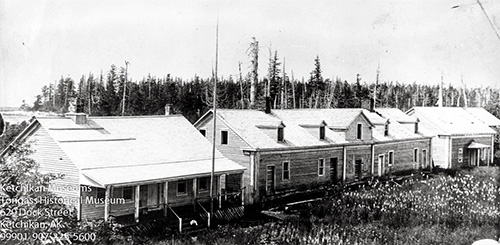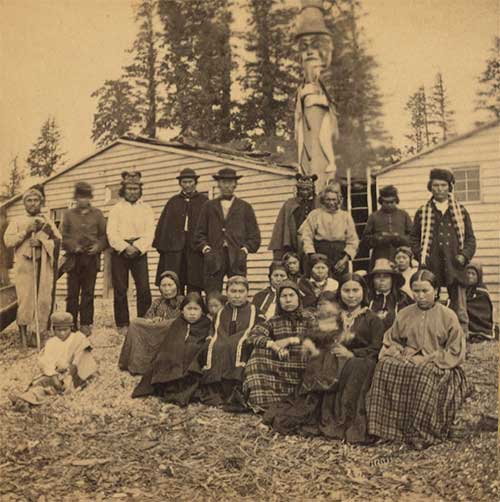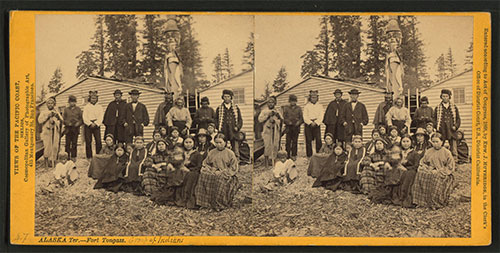The Short Life of Fort TongassMilitary base was on the border barely two yearsBy DAVE KIFFER November 03, 2020
A century and half after its brief role as the "muscle" at the Alaska/Canada border ended, Fort Tongass remains a fleeting foot note in Alaska history. The fort was officially abandoned on October 7, 1870. When the United States government purchased the Alaska territory for $7.2 million from Imperial Russia in 1867, there was almost no government infrastructure to absorb. The only Russian settlements in Southeast were Sitka and Wrangell and neither was anywhere near the Dixon Entrance border with Canada. Although there was a military presence in Sitka after the October transfer, a customs station - backed up by a military presence - was needed at the southern border, according to the only authority in the new territory, the US Army. A site was chosen on Tongass Island, adjacent to a long time Tlingit village. Tongass Village, the village of the Ganaxadi, had approximately 200 residents in the years that the fort operated.
The fort housed Battery E of the 2nd U.S. artillery under the command of Captain Charles H. Pierce. When the British Navy surveyed some of the nearby Canadian territory on the opposite side of nearby Portland Canal, the surveyors attemped to honor Pierce by naming the Canadian waterway after him, but misspelled his name, creating the modern Pearse Canal. In his 1886 history of Alaska, historian Hubert Bancroft noted that the site for the fort was "well chosen, containing a plentiful supply of timber and pasture, while fish and game abound in the neighborhood." But Bancroft would also note that the area was "dreary, the almost constant rain and soft soil produces mud of a most tenacious nature." He also noted that access to the island - especially by sailing ships - was poor and the anchorage even worse. A report by the US Army speaking in favor of the site for the fort also noted that access was bad and the site not optimal, but that the location was "the closest point to the border." The Fort was commissioned on April 29, 1868 and decommissioned on Oct. 7, 1870. A deputy customs collector was posted at the fort. At the time, there was traffic along the Inside Passage as prospectors were headed to the Stikine River to access gold fields in interior British Columbia, the so-called Cassiar area. Jefferson C. Davis the commander of the Military District of Alaska visited Fort Tongass in 1868 on the USS Saginaw and immediately requested an armed steamship be posted the area. The USS Cyane was sent north in 1869. It was stationed in Sitka but patrolled the entire region. The contingent that populated Fort Tongass had left Fort Steilacoom, near Lake Steilacoom south of Tacoma, when it was decommissioned in on April 22. The steamship Oriflamme carried the five officers and 112 enlisted men north, along with - according to military records - 14 serviceable mules, four unserviceable mules, two working oxen, two six-pound field guns and four mountain howitzers. They were accompanied by two non-military physicians, two non-military carpenters and two non-military stone masons. Captain Pierce was under orders to establish two different military bases. One at Fort Tongass and the other at Wrangell, with half of the detachment at each location. After establishing Fort Tongass site, half of the soldiers went on to Wrangell and established Fort Wrangell on May 5. Lt. John Smith was left in charge of Fort Wrangell and Pierce returned to Fort Tongass. In general, things at Fort Tongass were not unlike many of the isolated military outposts in the American West. There were relations with the neighboring Natives to consider. Smuggling across the border was always an issue. And the problems that arose when the sheer boredom overtook the soldiers and the civilians who worked with them. Historian Barton Penny published a history of Fort Tongass in 2019. He goes through the lengthy military reports that the soldiers were required to file. One thing he notes is, despite the two years spent on the site, it was clear that the soldiers themselves considered the installation "temporary in character." Probably the most interesting thing that Penny uncovers in his search of the military records is the court martial of the commanding officer, Captain Peirce.
Penny writes that the court martial grew out of the different world views of Captain Peirce and Lt. Eugene Murphy. At 43, Captain Peirce was a veteran of the Mexican War and the Civil War. He had received a field appointment to the officer corps in 1861 having never gone to the academy. He was toward the end of his military career. In fact, he would retire not long after Fort Tongass was decommissioned. By comparison, Murphy was a recent graduate of the US Military Academy and came from a higher social status than Capt. Peirce, having been born into a wealthy New York family. He immediately bristled when his commanding officer took issue with his work.
The situation came to head in September of 1869 when the two argued over the discipline of a sergeant for what Murphy called "mutinous behavior." Murphy ordered the sergeant arrested and Peirce had him released. Shortly after, Peirce gave Murphy a direct order regarding some paperwork and Murphy refused. Peirce had him jailed for several weeks. Immediately upon release, Murphy filed a complaint with the military command in Sitka. Both men were ordered held until a military court could be convened at Fort Tongass. "The location would automatically demand extraordinary circumstances," Penny wrote. "It was not as though the events about to transpire would occur in San Francisco, Portland, Seattle...this was Fort Tongass in the center of a vast wilderness. There were no cars, planes or trains, no electronic devices, no court stenographer, no texting, no messaging...the weather was poor and the accommodations humble." In November of 1869, the court convened to hear to the charges: Tyrannical conduct, arrest of a subordinate officer without cause, seizing private papers without cause, conduct unbecoming an officer, and being drunk on duty. After nine days of testimony and back and forth between the two sides, the court members - all senior officers from Sitka - met and quickly announced their verdict. Penny surmised they were in a hurry to be done with Fort Tongass. Peirce was found not guilty of tyrannical conduct, but he was found guilty of being drunk on duty several times and therefore guilty of conduct to the prejudice of good order and military discipline. Peirce was "cashiered" or fined, but the record doesn't say how much. Then the court met again the next day and ordered that Peirce receive "executive clemency" based on his 24 years of service and all charges were dismissed. General Davis in Sitka concurred with the action and Peirce served out the remainder of his time at Fort Tongass until the fort was decommissioned. Murphy, meanwhile, left Fort Tongass with the court officers and was sent to San Francisco to await a new military posting. He was sent first to Kansas and then back to the Presidio in San Francisco, finally ending up at Fort Alcatraz in San Francisco Bay. "In April (of 1872) he would decide to resign his commission, perhaps the result of recognizing that his military career was not likely to blossom any time soon after the failed attempt at bringing down his commanding officer," Penny wrote. Murphy would go on to be a prominent stockbroker in San Francisco, while Peirce - after retiring from the military - would join the US Lighthouse Service and retire as the senior keeper at Cape Blanco in Oregon. By 1870, the military had decided that maintaining multiple small " forts" along the Alaskan coast was too costly, especially in terms of keeping them supplied. It was decided to deactivate the forts in Kodiak, Wrangell and Tongass Island and concentrate resources in Sitka. Fort Tongass was officially abandoned on 7 Oct 1870 at 4:30 pm per S.O. 102, HQ Division of the Pacific, 3 Aug 1870. The command departed on the steamer Newbern leaving behind the acting assistant surgeon George Chismore on his own responsibility. According to the Alaska state archives, a newspaper was published briefly at Fort Tongass but no known copies of it remain. It was called the Tongass "Wa-Wa." "Wa-Wa" was Chinook jargon for "talk." Chinook jargon was a pidgin trade language used up and down the northwest coast where tribes and traders spoke different languages. Even after the Army left in 1870, a customs official stayed on site for several years and the entire island, including the village, was referred to as Fort Tongass in government records. The village population reached more than 700 in 1879, but then decreased afterward. As late as the 1890 census there was a still a presence listed for Fort Tongass. The Census determined there were 50 people living at the site, 43 Tlingits, six whites and one person of mixed race.
On the Web:
Contact Dave at dave@sitnews.us Dave Kiffer ©2020 Publication fee required. © Representations of fact and opinions in comments posted are solely those of the individual posters and do not represent the opinions of Sitnews.
|
|||||





